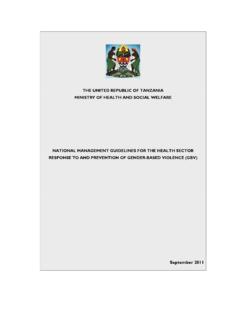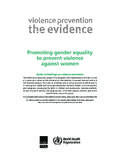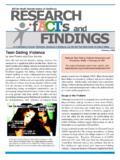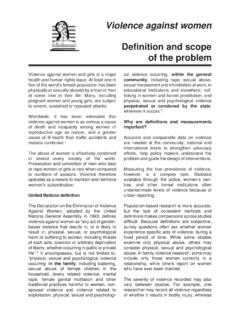Transcription of GUIDELINES FOR IMPACT OR OUTCOME …
1 GUIDELINES FOR IMPACT OR OUTCOME . evaluation . FOR PROJECTS FUNDED BY THE UNIFEM TRUST FUND TO. ELIMINATE violence AGAINST WOMEN. Produced for the gender and Development Group PREM. World Bank by Linde Rachel April 2006. i CONTENTS. 1. Background ..1. Selection of Trust Fund Projects ..2. Purpose and structure of the GUIDELINES ..4. PART ONE: DECISION GUIDELINES FOR UNIFEM .. 6. 1 IMPACT versus OUTCOME evaluation .. 6. 2 Design options for IMPACT and OUTCOME 7. Randomized or matched control group Ex-post comparison of project beneficiaries with control Rapid or other ex post OUTCOME assessments ..9. 3 Constraints to IMPACT or OUTCOME evaluation of Trust Fund 9. 4 Review of key issues for the evaluation of Trust Fund projects.
2 11. Time and budget constraints ..11. General Methodological considerations ..13. Questions to determine candidacy for IMPACT or OUTCOME evaluation ..14. Practical considerations for the implementation of PART TWO: METHODOLOGICAL GUIDELINES FOR IMPACT evaluation .. 18. 1 18. 2 Project design .. 19. Project Target OUTCOME Assumptions ..26. Rights-based analysis ..28. Checklist for project design ..29. 3 The collection of 29. Review of secondary data ..29. Collection of primary 4 Sampling .. 38. Probability sampling ..38. Purposive sampling ..39. Comparison Groups ..40. ii Proposed options for selected Trust Fund projects ..40. Specific sampling issues and procedures ..41. 5 Data Processing and Analysis .. 42.
3 Data Processing ..42. Data 6 Interpretation and Presentation of evaluation Results .. 45. Preliminary oral presentations and validations ..45. The evaluation 47. WEB BASED RESOURCES FOR PROJECT DESIGN AND 54. APPENDICES .. 57. 1 Summaries Of Selected 57. 2 UNIFEM Criteria for Evaluating TF Proposals .. 67. iii ACRONYMS. CDC Center for Disease Control CDD Community Driven Development CEDAW Convention on the Elimination of Discrimination Against Women CIS Commonwealth of Independent States CSPRO Census and Survey Processing System DHS Demographic and Health Surveys GBV gender Based violence IDRC International Development Research Centre IEG Independent evaluation Group LFA Logical Framework Approach LSMS Living Standards Measurement Study MICS Multiple Indicator Cluster Survey NGO Non Governmental Organizations RRA Rapid Rural Assessment SIF Social Investment Fund SMART Specific, Measurable, Achievable, Realistic, Time-related SPSS Statistical Package for the Social Sciences TF Trust Fund (UNIFEM).
4 UNDP United Nations Development Programme UNIFEM United Nations Development Fund for Women VAW violence Against Women WB World Bank WNGO Women's Non Governmental Organizations iv INTRODUCTION. Background The UN Trust Fund in Support of Actions to Eliminate violence Against Women was established by General Assembly Resolution 50/166 in 1996 and is managed by the United Nations Development Fund for Women (UNIFEM). In establishing the Trust Fund, the General Assembly highlighted eliminating violence against women as critical to accelerating the implementation of the 1995 Beijing Declaration and Platform for Action. Acts or threats of violence against women, wherever they occur, constitute a violation of human rights and an obstacle to the achievement of equality, development and peace.
5 1. UNIFEM began its work in the area of violence against women in 1993, when pressure by civil society organizations on their governments had led to the UN Declaration to End violence against Women, and in accordance with its support to women's networks organizing for the World Conference on Human Rights in 1994. UNIFEM was one of the first UN agencies that translated the UN Declaration of 93 and the Platform for Action of 95 into concrete programs that aim to end VAW. 2. According to the Fund's operational GUIDELINES , the emphasis of the trust fund is on innovative models and strategic interventions , providing funding for innovative and catalytic initiatives that seek to prevent and eliminate violence against women.
6 3 The idea is to provide grants to projects that can later serve as examples for replication in other countries. 4. The Trust Fund invites proposals from civil society organizations worldwide that have experience in local gender -related issues. It disburses approximately $1 million a year, which funds only a small percentage of proposals received (for example, 18 out of 270, or 7%, in 2002). Through 2004, individual grants have been relatively small, averaging about $50,000 for periods of 1 to 2 years. Recently, the Trust Fund committed itself to making larger and longer grants, which will range from $100,000 to $200,000 for periods of 2 to 3 years. Project proposals are selected and funds are granted on an annual basis by a global Program Appraisal Committee (PAC) composed of at least 9 UN organizations and a small number of international NGOs working on ending violence against women.
7 In 2005, the Trust Fund decision-making process was devolved to regional review committees in an effort to bring decision-making closer to the ground and secure greater involvement of the UN Country Teams in deciding on, monitoring, and linking with Trust Fund programs. Since its inception, the trust fund provides not only for project implementation, but also for the evaluation of project IMPACT . Project proposals generally set aside 10% for project evaluation , which corresponds to the general rule of thumb. In recent years the importance of IMPACT evaluation to the trust fund management has been underscored by separate GUIDELINES for 1. United Nations, General Assembly: A/RES/50/166 (99th plenary, 22 December 1995), with reference to the Vienna Declaration of 1993.
8 2. Desk Review of UNIFEM's Work to End violence Against Women, submitted by the Education Development Center. 14 April 2002, 3. Operational GUIDELINES for the Trust Fund in Support of Actions to Eliminate violence Against Women, 2001. 4. Introductory statement from the UNIFEM Trust Fund website. GUIDELINES for IMPACT and OUTCOME evaluation : Introduction 1. project IMPACT assessment that are attached to proposal GUIDELINES . In practice, however, the projects are rarely subjected to systematic and technically defensible IMPACT evaluations. At a workshop held by the World Bank on the Development Implications of gender -Based violence in November of 2004, workshop participants, including UNIFEM representatives, identified the need to conduct systematic evaluations of the trust fund projects in order to determine their effectiveness in addressing gender -based violence .
9 5 The associated recommendation was to develop an evaluation guide that UNIFEM can use to conduct IMPACT evaluations of its existing and future portfolios of projects. The current document represents the first step in this endeavor: the drafting of a guide to IMPACT evaluation based on a representative sample of fifteen projects, drawn randomly from the list of Trust Fund projects funded and completed to date. Selection of Trust Fund Projects Using the complete listing of projects that had been completed to date, a systematic random sample of fifteen projects was selected. 6 Six of the projects had been funded prior to the year 2000 and nine between 2000 and 2004. The majority of the grants (9) received funds between $ 40-60,000.
10 Five projects received less and only one received more ($110,000). The duration of the funding period was one year for 12 out of the 15 projects. Three projects exceeded that duration to a maximum of 22 months. A more detailed description of each project is provided in Appendix 1. From its inception until 2004, the GUIDELINES for grant-making decisions described strategies to be supported under six general headings: Awareness raising and advocacy, capacity building for organizations, legal literacy projects, gender -sensitivity training, violence prevention initiatives, action-related research. These are clearly not discrete or mutually exclusive categories. All projects included some element of awareness raising and/or knowledge increase in their strategic objectives, and for most of them (13) these are combined with other change objectives.

















